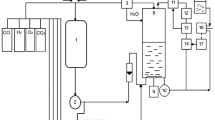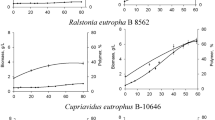Abstract
Objectives
To autotrophically produce polyhydroxyalkanoate (PHA) by Ralstonia eutropha without the risk of gas explosion, the feasibility of using a non-combustible gas mixture with low hydrogen content was investigated.
Results
A non-combustible gas mixture (H2: O2: CO2: N2 = 3.6: 7.6: 12.3: 76.5) was used for a 144-hour flask cultivation of two R. eutropha strains. Initially, using strain H16, the production conditions for poly(3-hydroxybutyrate) [P(3HB)] were explored by examining nutrient deficiency. Of these, a nitrogen source-deficient culture medium yielded the highest polymer content of 70 wt% in cells. Next, to produce PHA copolymer, the recombinant strain 1F2 was cultured under the nitrogen source-deficient autotrophic condition. As a result, the accumulation of 3HB-based copolymer containing of 1.2 mol% 3-hydroxyvalerate unit and 1.2 mol% 3-hydroxy-4-methylvalerate unit was observed with 57 wt% of the cell content.
Conclusions
The use of a non-combustible gas with low hydrogen content is beneficial for PHA production in eliminating the risk of explosion due to hydrogen leakage.


source-deficiency on P(3HB) accumulation of R. eutropha H16 harboring pBBR1MCS-2 (empty plasmid). The cells were cultured in baffled Erlenmeyer flasks with a low hydrogen gas mixture (3.6% H2, 7.6% O2, 12.3% CO2, 76.5% N2,) at 30 °C for 144 h by exchanging the gas mixture every 24 h. a Dry cell weight, b P(3HB) yield, c P(3HB) content in the cells



Similar content being viewed by others
References
Garcia-Gonzalez L, Mozumder MSI, Dubreuil M, Volcke EI, De Wever H (2015) Sustainable autotrophic production of polyhydroxybutyrate (PHB) from CO2 using a two-stage cultivation system. Catal Today 257:237–245
Ishizaki A, Tanaka K, Taga N (2001) Microbial production of poly-D-3-hydroxybutyrate from CO2. Appl Microbiol Biotechnol 57:6–12
Kovach ME, Elzer PH, Hill DS, Robertson GT, Farris MA, Roop R, Peterson KM (1995) Four new derivatives of the broad-host-range cloning vector pBBR1MCS, carrying different antibiotic resistance cassettes. Gene 166:175–176
Liu C, Colón BC, Ziesack M, Silver PA, Nocera DG (2016) Water splitting–biosynthetic system with CO2 reduction efficiencies exceeding photosynthesis. Science 352:1210–1213
Miyahara Y, Oota M, Tsuge T (2018) NADPH supply for poly(3-hydroxybutyrate) synthesis concomitant with enzymatic oxidation of phosphite. J Biosci Bioeng 126:764–768
Przybylski D, Rohwerder T, Dilßner C, Maskow T, Harms H, Müller RH (2015) Exploiting mixtures of H2, CO2, and O2 for improved production of methacrylate precursor 2-hydroxyisobutyric acid by engineered Cupriavidus necator strains. Appl Microbiol Biotechnol 99:2131–2145
Raberg M, Voigt B, Hecker M, Steinbüchel A (2014) A closer look on the polyhydroxybutyrate- (PHB-) negative phenotype of Ralstonia eutropha PHB-4. PLoS ONE 9:e95907
Saika A, Watanabe Y, Sudesh K, Abe H, Tsuge T (2011) Enhanced incorporation of 3-hydroxy-4-methylvalerate unit into biosynthetic polyhydroxyalkanoate using leucine as a precursor. AMB Express 1:6
Saika A, Ushimaru K, Mizuno S, Tsuge T (2015) Genome-based analysis and gene dosage studies provide new insight into 3-hydroxy-4-methylvalerate biosynthesis in Ralstonia eutropha. J Bacteriol 197:1350–1359
Sugimoto T, Tsuge T, Tanaka K, Ishizaki A (1999) Control of acetic acid concentration by pH-stat continuous substrate feeding in heterotrophic culture phase of two-stage cultivation of Alcaligenes eutrophus for production of P(3HB) from CO2, H2, and O2 under non-explosive conditions. Biotechnol Bioeng 62:625–631
Tanadchangsaeng N, Kitagawa A, Yamamoto T, Abe H, Tsuge T (2009) Identification, biosynthesis, and characterization of polyhydroxyalkanoate copolymer consisting of 3-hydroxybutyrate and 3-hydroxy-4-methylvalerate. Biomacromol 10:2866–2874
Tanaka K, Ishizaki A, Kanamaru T, Kawano T (1995) Production of poly(D-3-hydroxybutyrate) from CO2, H2, and O2 by high cell density autotrophic cultivation of Alcaligenes eutrophus. Biotechnol Bioeng 45:268–275
Tsuge T (2002) Metabolic improvements and use of inexpensive carbon sources in microbial production of polyhydroxyalkanoates. J Biosci Bioeng 94:579–584
Tsuge T, Yano K, Imazu SI, Numata K, Kikkawa Y, Abe H, Taguchi S, Doi Y (2005) Biosynthesis of polyhydroxyalkanoate (PHA) copolymer from fructose using wild-type and laboratory-evolved PHA synthases. Macromol Biosci 5:112–117
Volova TG, Kiselev EG, Shishatskaya EI, Zhila NO, Boyandin AN, Syrvacheva DA, Vinogradova ON, Kalacheva GS, Vasiliev AD, Peterson IV (2013) Cell growth and accumulation of polyhydroxyalkanoates from CO2 and H2 of a hydrogen-oxidizing bacterium, Cupriavidus eutrophus B-10646. Biores Technol 146:215–222
Yu J (2014) Bio-based products from solar energy and carbon dioxide. Trends Biotechnol 32:5–10
Zabetakis MG (1965) Flammability characteristics of combustible gases and vapors. No. BULL-627. Bureau of Mines, Washington DC
Acknowledgements
The authors gratefully thank Mr. K. Ishihara (Teijin Co., Tokyo, Japan) for helpful discussion regarding this work. This work was supported by a Grant-in-Aid for Scientific Research (KAKENHI 19K22923), Japan.
Supporting information
Supplementary Figure 1—The gas composition used in this study.
Supplementary Figure 2—The procedure of gas exchange in a flask
Author information
Authors and Affiliations
Corresponding author
Ethics declarations
Conflict of interest
The authors declare that they have no conflict of interest.
Additional information
Publisher's Note
Springer Nature remains neutral with regard to jurisdictional claims in published maps and institutional affiliations.
Electronic supplementary material
Below is the link to the electronic supplementary material.
Rights and permissions
About this article
Cite this article
Miyahara, Y., Yamamoto, M., Thorbecke, R. et al. Autotrophic biosynthesis of polyhydroxyalkanoate by Ralstonia eutropha from non-combustible gas mixture with low hydrogen content. Biotechnol Lett 42, 1655–1662 (2020). https://doi.org/10.1007/s10529-020-02876-3
Received:
Accepted:
Published:
Issue Date:
DOI: https://doi.org/10.1007/s10529-020-02876-3




